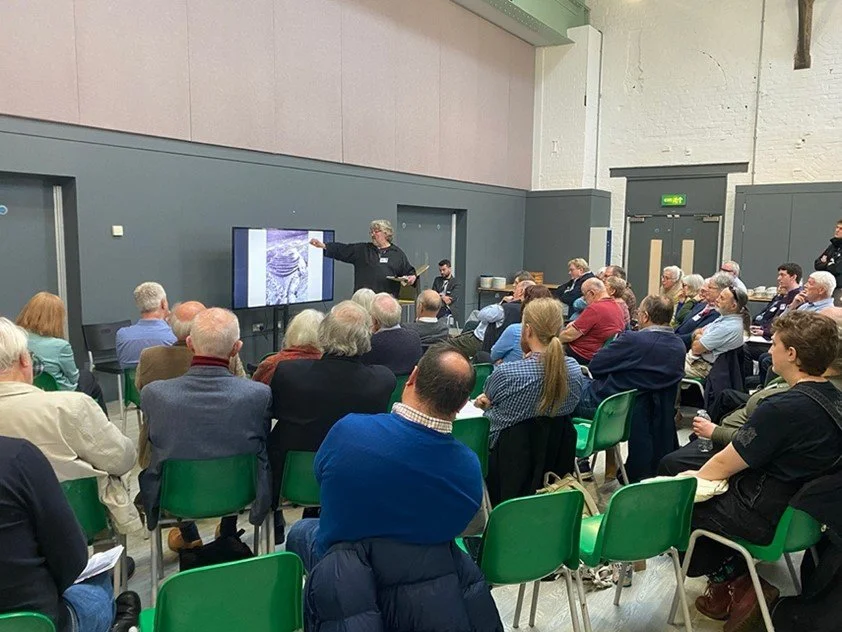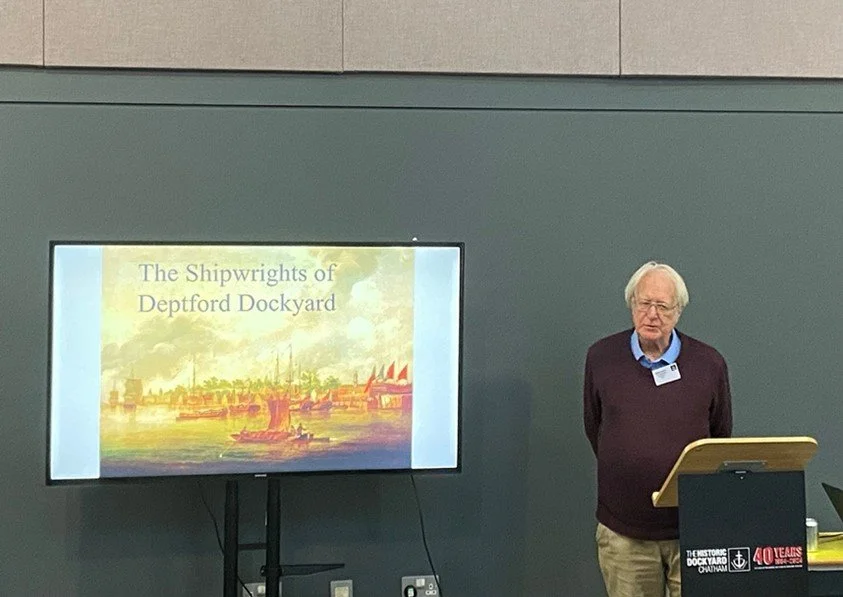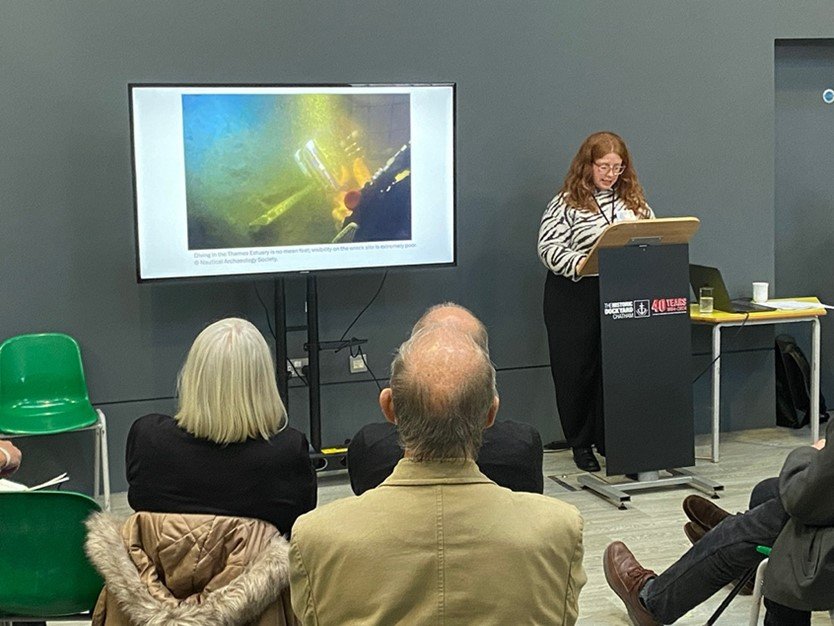The Maritime Kent Special Interest Group Conference 2024: Shipbuilding in Kent
The KAS Maritime Kent Research Group reports on The Kent Shipbuilding Conference held at Chatham Historic Dockyard on the 7th and 8th November 2024.
We’re pleased to say that our first event, the Shipbuilding in Kent Conference at Chatham Historic Dockyard on 7–8 November, was a great success.
A variety of speakers introduced subjects relating to shipbuilding in the county, the idea being to test the water in terms of subject areas with a view to more focused events in the future. It was also a chance to gauge the level of interest in maritime heritage and to get the thoughts of both delegates and speakers on the purpose and future of the MKSIG. Among those who attended were people involved in archaeology, restoration, boatbuilding, historical research, volunteering, local museums, engagement projects, curation, research, and family history. It was a fantastic opportunity for a group with such varied professional and personal maritime interests to come together and share their knowledge and experience.
The conference was jointly organised and hosted by the MKSIG under the Kent Archaeological Society (KAS) and Chatham Historic Dockyard Trust (CHDT), and attracted about 80 delegates over the two days. The Trust's CEO, Richard Morsley, introduced the conference with an address covering the 400-year history of Chatham Dockyard, including its transformation into an important heritage site and its plans for continued heritage and historical work in the future.
Richard Morsley, CEO of CHDT, gives the keynote speech (photo: Vanessa Sanderson)
Day One began with a session of talks on Restoration and Replica, with Paul Bennett discussing the discovery, conservation, and replica building of the Dover Bronze Age Boat. The talk focused particularly on the construction of the half-scale replica, from a review of principal components of the boat discovered in 1992 to its launch in 2012 as a working boat and an archaeological experiment. Paul is Chairman of the Dover Bronze Age Boat Trust and dedicated his talk to the memory of the three men who were integral to the project: Ole Crumlin-Pedersen, a Danish nautical archaeologist who designed the replica; Richard Darrah, an ancient woodworking specialist and experimental archaeologist from Norfolk who led the construction team; and Peter Clark of Canterbury Archaeological Trust who managed the project.
Paul Bennett on the Dover Bronze Age Boat (photo: Vanessa Sanderson)
Gordon Vincent then presented a talk on Gamecock: a Whitstable oyster yawl undergoing restoration by Whitstable Maritime using traditional materials and techniques. Gordon, who founded the charity Whitstable Maritime, covered the history of the oyster yawl and the families which relied upon those vessels, before discussing the restoration of Gamecock and its future as a working boat, a tourist attraction, and a modern community focus helping disadvantaged young people and adults.
Gordon Vincent presents the Gamecock (photo: Vanessa Sanderson)
Our second session of Day One focused on Ship Archaeology. Peta Knott, Education Manager of the Nautical Archaeology Society, delved into the mysteries of the Sandwich Bay wooden wrecks and invited those present to comment on and contribute to investigation on those vessels. The remains of ten unidentified wooden vessels offer tantalising glimpses into the past for beach walkers at low tide. Peta's discussion outlined the physical remains recorded so far, showing the extensive work done and potential research avenues for the future, with plenty of archaeology and research volunteer opportunities in the near future.
Peta Knott on the unidentified wrecks at Sandwich Bay (photo: Vanessa Sanderson)
Damian Goodburn, PhD and archaeological woodwork specialist, followed with his discussion of the late-Saxon period Graveney boat, an ancient clinker-built boat found in the Graveney marshes near Faversham in September 1970. Damian's talk covered the vessel's excavation and placed the find in historical context with archaeological evidence for other early craft found in the south-east corner of England.
Damian Goodburn discusses the Graveney boat (photo: Vanessa Sanderson)
Our final session of the day looked into Shipbuilders and Social History, revealing some fascinating stories about the people whose livelihoods depended on Kent's shipbuilding industries. Brian Lavery spoke about the shipbuilders of Deptford Dockyard using research from surviving letter books for the period 1690–1815, perhaps the most detailed record of any industrial organisation before the 19th century. The talk focused particularly on the shipwrights, and provided insights into their private and communal lives in the town of Deptford. Several working shipwrights were discussed, including Josias Slade, ‘married to the female shipwright’, the apprentices and their lives, as well as older and infirm men who were employed in the boathouse and masthouse. Brian Lavery is an experienced yachtmaster, historian, author, and TV and film consultant (including Master and Commander and Empire of the Seas), and it was a pleasure to hear him speak.
Brian Lavery on the shipwrights of Deptford Dockyard (photo: Vanessa Sanderson)
The second talk was a last-minute change, with Chatham Historic Dockyard's Interpretation Officer Paul Wright heroically standing in for David Killingray, who unfortunately could not attend. Paul's talk provided an overview of the Dockyard's growing collection of small boats and craft, which tell their own unique stories that Paul and the team are looking to develop and present to a wider audience over the next 10 years.
Paul Wright discusses Chatham Dockyard's small boats and craft (photo: Vanessa Sanderson)
The final talk of both the session and the day was a fascinating personal family history from Sarah Austin who has researched three generations of barge builders and shipwrights in Kent. The changing fortunes and evolving practices of her family's history were explored through documentary evidence, including census returns, trade directories, newspaper articles, photographs, and papers from H. M. Dockyard Chatham. This evidence was also placed within a broader social context using extracts from the 1974 autobiography of Sarah's grandfather, Len Austin.
Sarah Austin shares her family history of Kent barge builders and shipwrights (photo: Vanessa Sanderson)
Day Two began with a very interesting session on Shipbuilding during Wartime. Local historian and RNLI volunteer Colin Varrall presented a lesser-known history of shipbuilding at Richborough Port during the First World War. Richborough is perhaps more commonly known for the arrival of the Roman fleet of Emperor Claudius, who established a fort during AD 43. However, Richborough's position became strategically important during the First World War when the Royal Engineers developed two shipbuilding yards to assemble specially designed cross-Channel barges. Colin's talk examined the area not only for the importance of its geographical location but also for innovative shipbuilding techniques that were developed there during the war.
Colin Varrall on shipbuilding at Richborough Port (photo: Vanessa Sanderson)
Colin's talk was followed by another interesting presentation in which Henry Cleary looked at Faversham shipbuilders James Pollock, Sons and Co. and its sometimes strained relations with the Admiralty during the Second World War. Henry is a Trustee of the Maritime Heritage Trust and based his talk on extensive research into the archive of Pollock papers held by the National Maritime Museum at Greenwich. Several interesting aspects emerged from Henry's research, including the collaboration with other small yards that would normally have competed against Pollocks; shrewd business negotiations which protected the yard against cancelled orders and other unforeseen circumstances; and Pollocks' enduring reputation for quality workmanship, with many employees enjoying long service careers.
Henry Cleary explores relations between Pollock & Sons and the Admiralty (photo: Vanessa Sanderson)
David Patient began Friday's second session on Resources and Research by presenting his investigations for a new book, Tilt Boats & Hatch Boats of Gravesend & the London River, 1555–1865 (Jardine Press, 2024), which is sponsored by KAS. On his retirement as a shipwright, David made a study of the maritime history of Gravesend in the days of sail, in particular the building and operation of the tilt boat and hatch boat. Tilt boats, hatch boats, naval warships, merchant ships, cod smacks, and passenger steamers were all launched at Gravesend from local yards. The development from barge to tilt boat, the demand for naval ships, and the deep-sea fishing industry that sustained the hatch boat’s trade were all discussed in context.
David Patient presents research from his new book, Tilt Boats & Hatch Boats of Gravesend (photo: Vanessa Sanderson)
Alex Grover then provided a very useful overview of the collections of ship plans at the National Maritime Museum, Greenwich, with a particular focus on Kent. The Admiralty collection is a near-unbroken run from the late 1600s to the 1970s and includes those ships built by royal and private yards within Kent over that period. The merchant collections not only include ships built in Kent from companies like Pollocks of Faversham, but also draughtsmen like Philip Oke who took the lines from vessels that operated in the county – at the time in danger of being broken up without a record. The Museum’s maritime photographic collection is large and varied, and includes images of Kent as a place of work and play, putting the vessels built there into their cultural context. Alex provided some great examples from the collections in addition to information on how to access the material for research.
Alex Grover explores the NMM's collection of ship plans (photo: Vanessa Sanderson)
Dr Philip MacDougall kicked off our final session of the conference, Shipbuilding at Chatham, with a lively talk on HMS Achilles, the first true iron-hulled battleship to be built in a royal dockyard. Previous to the building of Achilles in 1863, all large warships at naval dockyards had been built of timber. Philip covered the reasons why Chatham was chosen for the building of Achilles, the changes that were necessary to undertake the task, and the problems which were overcome to ensure her construction. Also discussed were the resulting extension to Chatham and the legacy of Achilles, which brought a massive increase in the size of the yard's workforce and transformed the towns of Chatham and Gillingham.
Dr Philip MacDougall on HMS Achilles (photo: Vanessa Sanderson)
Our next speaker, Matthew Bellhouse Moran, travelled down from Dundee to give a talk on Chatham-built HMS Unicorn, a 46-gun frigate launched in 1824. Unicorn arrived in Dundee in 1873 as a training ship for the Royal Naval Reserves – a role she carried out until the 1960s when she was in danger of being broken up. In order to preserve the ship for future generations, the Unicorn Preservation Society (UPS) was formed. HMS Unicorn is still moored on the city’s waterfront and is now the oldest ship left in Scotland, as well as one of the six oldest ships in the world. Matthew's eye-opening talk focused on the progress and setbacks of trying to preserve Unicorn into the 21st century through his work with Project Safe Haven, which aims at creating a sustainable future for the ship. The discussion highlighted the difficulties of maritime heritage preservation and the dedication and determination of teams trying to protect such heritage for as long as possible.
Matthew Bellhouse Moran discusses the preservation of HMS Unicorn (photo: Vanessa Sanderson)
The final talk of the conference was presented by Jools Maxwell, Archaeology Curator for Southend Museums, and focused on the rediscovery and excavation of the wreck of the London, a warship built at Chatham between 1654 and 1656. She sank in 1665 off the Southend coast following a mysterious explosion. Jools discussed the London's fate and subsequent rediscovery and underwater archaeological excavation of the wreck, which have provided valuable insights into naval operations and everyday life onboard a 17th century warship. Jools brought home the challenges of excavating a wreck site in a low visibility, highly tidal environment and examined some of the objects recovered.
Jools Maxwell on excavations of the London wreck (photo: Vanessa Sanderson)
Included with this variety of talks were entrance to the entire Dockyard site; guided tours of the archive and reading room, the conservation lab, and of HMS Ocelot; and a chance to hear from a diver who served onboard HMS Cavalier. It was also great to see the level of interaction and conversation between sessions and over lunch, with many people commenting that they had made very useful contacts.
The conference drew to a close with an opportunity for speakers and delegates to put forward comments and ideas to the steering group about the direction of the MKSIG and future events. It was a very worthwhile experience for the steering group to hear the thoughts of attendees with a range of expertise and a similar passion for Kent's maritime heritage and history. The steering group will meet after Christmas for further discussion about the ideas put forward, which included more specialist events relating to specific areas such as archaeology; the four naval dockyards in Kent; and maritime archives. The discussion will also include the possibility of a similar annual event at different maritime locations around Kent. One thing was clear – there is a huge amount of interest in the rich maritime heritage of the county!
The MKSIG Steering Group in discussion (photo: Jason Mazzocchi)
Finally, we want to take this opportunity to extend our heartfelt thanks to our speakers and to everyone who attended. Particular thanks also go to Nick Ball and the team at Chatham Historic Dockyard for being fantastic hosts and ensuring the conference ran so smoothly over the two days.
We received some encouraging and helpful feedback from attendees, of which just a few examples are included here, but our sincere thanks go to everyone who took the time to comment.
Brilliant! It should be an annual thing.
Excellent venue and selection of talks. Enjoyed meeting new people.
Good mix of people from different backgrounds and disciplines.
Really enjoyed the venue, great to have talks and then an opportunity to see some of the dockyard during lunch. Even better - the opportunity for a tour on both days.
Most enjoyable! Definitely worth doing again. Keeps everyone informed of current projects and developments.
Twenty minutes was the perfect length for talks for me as a non-specialist. I enjoyed the opportunity to talk to the speakers during the breaks. I can now go on and research some of these areas I’m now interested in. A really friendly and enjoyable two days.
A real privilege to be involved.
Loved the social history content: real families and photos/prints/ paintings/descriptions of seaside towns. Brought it to life.
We will be sharing our upcoming discussions soon, but in the meantime a reminder that our Facebook page is now active, so please follow us, share our page and comment. We encourage involvement and collaboration, so do message us if you have ideas or information about maritime heritage projects and events in Kent. Follow this link to visit our Facebook page:
We look forward to exploring more of Kent's rich maritime heritage and history in the future!
The Maritime Kent Special Interest Group
Stuart Bligh, Martin Crowther, Catherine Holt, Keiron Hoyle, Emma Ovenden and Vanessa Sanderson
















